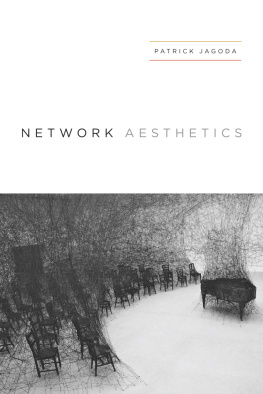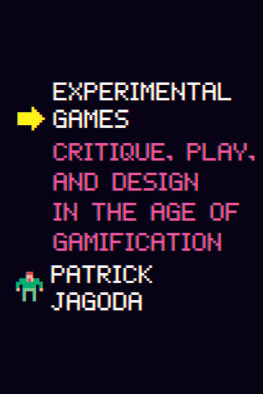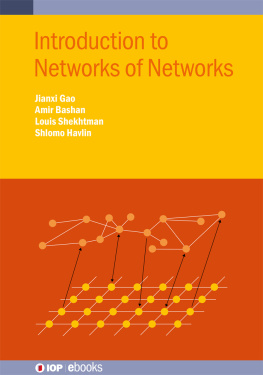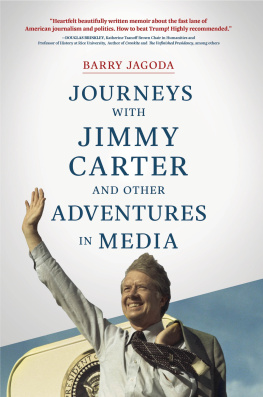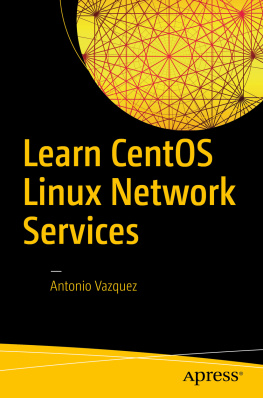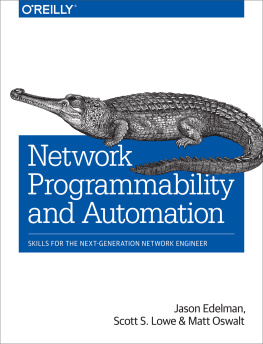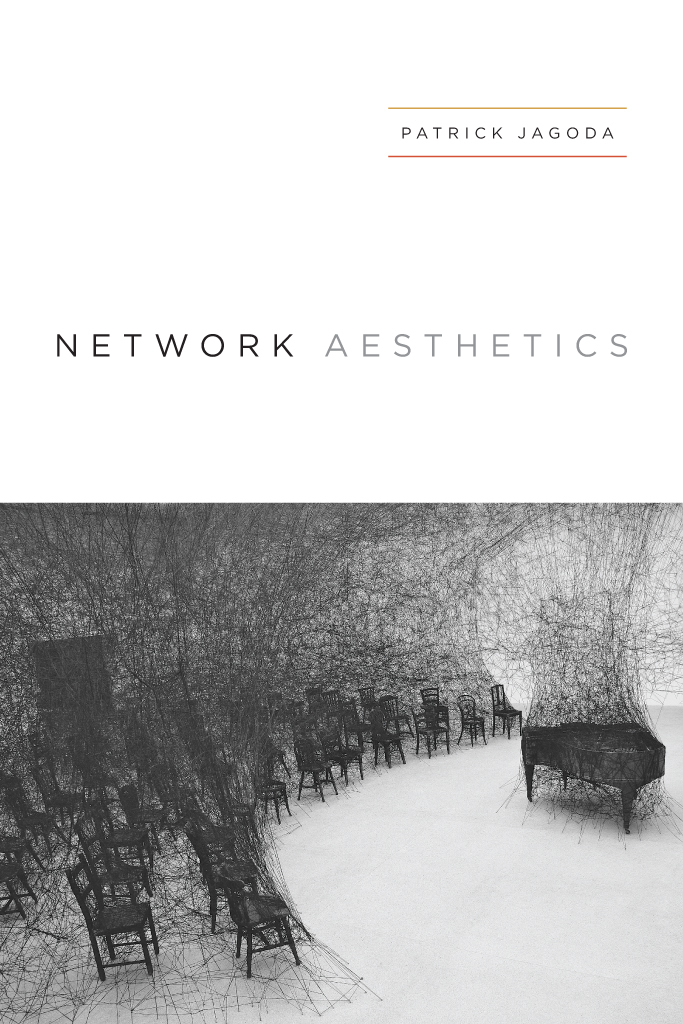Network Aesthetics
Patrick Jagoda
The University of Chicago Press
Chicago and London
Patrick Jagoda is assistant professor of English at the University of Chicago and a coeditor of Critical Inquiry.
The University of Chicago Press, Chicago 60637
The University of Chicago Press, Ltd., London
2016 by The University of Chicago
All rights reserved. Published 2016.
Printed in the United States of America
25 24 23 22 21 20 19 18 17 16 1 2 3 4 5
ISBN-13: 978-0-226-34648-9 (cloth)
ISBN-13: 978-0-226-34651-9 (paper)
ISBN-13: 978-0-226-34665-6 (e-book)
DOI: 10.7208/chicago/9780226346656.001.0001
The University of Chicago Press gratefully acknowledges the generous support of the Division of the Humanities at the University of Chicago toward the publication of this book.
Library of Congress Cataloging-in-Publication Data
Jagoda, Patrick, author.
Network aesthetics / Patrick Jagoda.
pages cm
Includes bibliographical references and index.
ISBN 978-0-226-34648-9 (cloth : alkaline paper)
ISBN 978-0-226-34651-9 (paperback : alkaline paper)
ISBN 978-0-226-34665-6 (e-book)
1. ArtsPhilosophy. 2. Aesthetics. 3. Cognitive science. I. Title.
BH39.J34 2016
302.23'1dc23
2015035274
This paper meets the requirements of ANSI/NISO Z39.48-1992 (Permanence of Paper).
This book is dedicated to an assemblage of friendsincluding the late-night conversational, the lifelong, and the social media varietiesto whom I am grateful for inspiration and discussion, collaboration and argument, shared meals and intellectual support. Whenever I undertake the difficult task of thinking through and beyond network form, I constellate you in my imagination.
Contents
Journey (2012) |
We the Giants (2009) |
Network visualization of a Flickr tag search (2013) |
Twitch Plays Pokmon (2014) |
Visualization of Instagram network (2012) |
Bob Barnes and Prince Nasir Al-Subaai from Syriana (2005) |
A CIA agent from Syriana (2005) |
The CIAs Gods-eye-view from Syriana (2005) |
Migrant workers from Syriana (2005) |
David Parenti from The Wire (2006) |
Bulletin board from The Wire (2002) |
Mapping a network from The Wire (2002) |
America at War from The Wire (2002) |
Main interface of Uplink (2001) |
Global map interface of Uplink (2001) |
Between sleeping and waking in Between (2008) |
Basic gameplay in Between (2008) |
Expanded inventory in Between (2008) |
The impossibility of a direct encounter with the other player in Between (2008) |
The sublime landscapes of Journey (2012) |
Journey Stories Tumblr blog (2012) |
Marionette rabbit hole from The Project (2013) |
Final event from The Project (2013) |
The Grand Ort from The Project (2013) |
Twitter account for The Project (2013) |
Facebook page for The Project (2013) |
Collaborative collage from Speculation (2012) |
In Times Square Red, Times Square Blue, Samuel (Chip) Delany suggests two distinct but overlapping terms to describe social ways of being in the worldcontact and networking. Contact may take place in line at the grocery store, in intense conversation at home, or at the copy machine at work. Networking, on the other hand, may happen at conferences, cocktail parties, or workshops. During the time I have worked on Network Aesthetics, I have been fortunate enough to learn a great deal from friends, family, and colleagues through both contact and networking, from intimate conversation and casual exchange to face-to-face debates and indirect inspirations, that I can capture only provisionally through my citations and these acknowledgments.
Any projecteven a single-authored monographis a large-scale collaboration. A number of people volunteered significant time and attention to help me move through countless drafts of this book. This project would have been absolutely impossible without the sustained and meticulous close reading of manuscript drafts by Scott Bukatman, Jim Hodge, Keith Jones, Patrick LeMieux, Tara McPherson, Daniel Morgan, and Priscilla Wald. Im grateful for advice and ongoing conversations, in the years leading up to publication, with Lauren Berlant, Bill Brown, Jim Chandler, Hillary Chute, Cathy Davidson, Frances Ferguson, Abe Geil, Tom Gunning, Timothy Harrison, Katherine Hayles, Tim Lenoir, Tom Mitchell, Larry Rothfield, and Avery Slater. I also owe much to a quarter of intense discussions with my co-instructor Eivind Rssaak and the graduate students who participated in the Center for Disciplinary Innovation Network Aesthetics | Network Cultures seminar at the University of Chicago.
People who have been equally crucial to my thinking, without necessarily needing to read a single draft, are my family, especially Irus, Ziggy, David, and Mark. Also, thanks to Kristen Schilt, who has taught me some indispensable things about shared projects, queer families, and thick partnerships.
Im thankful for more local (but no less important) contributions from several colleagues along the way. For help with the introduction: Adrienne Brown, Andrew Leong, Nasser Mufti, John Muse, Debbie Nelson, Zachary Samalin, and the University of Chicago English Department. For shaping my thought about , thanks to the attendees of the Debating Visual Knowledge symposium at the University of Pittsburgh, the Post45 workshop at the University of Chicago, and the Every Wednesday Lecture at the Franke Institute for the Humanities, at which I presented this work. Also, I appreciate feedback on earlier versions from Stephanie Boluk, Doron Galili, Mollie McFee, Lisa Nakamura, Scott Richmond, and Richard Jean So.
Of all of the parts of Network Aesthetics, required the greatest number of risks and revisions. I consider myself lucky for exchanges with David Levin and Leslie Danzig, as well as Sha Xin Wei, the students of my Transmedia Games: Theory and Design course, and members of the Topological Media Lab with whom I created the alternate reality game (ARG) The Project. Also, special thanks to participants in my Network Art: Distance, Intimacy, and Correspondence independent study, with whom I began to really think through the complicated form of ARGs: Peter McDonald, Phil Ehrenberg, Ellen Kladky, Bea Malsky, Kalil Smith-Nuevelle, and Ashlyn Sparrow. From my collaborators at the Game Changer Chicago Design Lab, especially Melissa Gilliam, I have learned so much about creating alternate reality games. This chapter would also not have been possible without the generous fellowship from the Richard and Mary L. Gray Center for Arts and Inquiry that allowed me to experiment, fail in interesting ways, and, as a result, find my way to more nuanced thoughts.
For his careful attention, throughout the review and editorial process, many thanks to Alan Thomas at the University of Chicago Press. Also, I appreciate the patience and crystal-clear responses to my queries from Randy Petilos, Joel Score, and my careful copy editor, India Cooper. Im grateful . Also, many thanks to my fantastic RA Joshua Kopin and to Stephanie Kaufman for their careful assistance in preparing the final manuscript. Additional proofreading assistance came from Bill Hutchison, Haitham Ibrahim, and Jean Thomas Tremblay.

